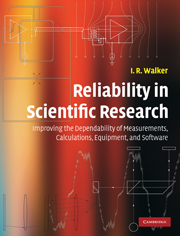 Reliability in Scientific Research
Reliability in Scientific Research Published online by Cambridge University Press: 05 June 2012
Introduction
The main purpose of this chapter is to examine certain trouble-prone aspects of experimental work that are often not considered, but if neglected can have major consequences. These include errors caused by the subconscious biases of experimenters, which are often the origin of mistaken conclusions in scientific research. In those areas of research that involve the study of material samples, very serious errors are commonly made because the true compositions of the samples are different from what is believed. This issue is also discussed below. The chapter also looks at the problems that can arise in reproducing the experimental measurements and techniques of other researchers. Several of the points are illustrated by historical examples. Some potential pitfalls in the analysis of data are discussed here, and also in Section 2.2.7.
Knowing apparatus and software
It is important to understand (at least at the conceptual level, if not in all the details) the inner workings of one's apparatus and software, and the theories they are based on. The effort needed to acquire this understanding is often avoided by experimenters. This tendency is encouraged by the ubiquitous presence in laboratories of highly automated commercial instruments, which are easy to treat as black boxes.
Having a conceptual understanding of apparatus and software can help to reduce human errors that might otherwise occur during their use (see page 17). Also, without such an understanding, the limitations and eccentricities of these things may not be readily perceived.
To save this book to your Kindle, first ensure [email protected] is added to your Approved Personal Document E-mail List under your Personal Document Settings on the Manage Your Content and Devices page of your Amazon account. Then enter the ‘name’ part of your Kindle email address below. Find out more about saving to your Kindle.
Note you can select to save to either the @free.kindle.com or @kindle.com variations. ‘@free.kindle.com’ emails are free but can only be saved to your device when it is connected to wi-fi. ‘@kindle.com’ emails can be delivered even when you are not connected to wi-fi, but note that service fees apply.
Find out more about the Kindle Personal Document Service.
To save content items to your account, please confirm that you agree to abide by our usage policies. If this is the first time you use this feature, you will be asked to authorise Cambridge Core to connect with your account. Find out more about saving content to Dropbox.
To save content items to your account, please confirm that you agree to abide by our usage policies. If this is the first time you use this feature, you will be asked to authorise Cambridge Core to connect with your account. Find out more about saving content to Google Drive.